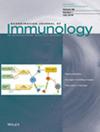无肥大细胞受累征兆的长 COVID:一项病例对照研究
IF 1.6
4区 医学
Q2 IMMUNOLOGY
引用次数: 0
摘要
由 SARS-CoV-2 感染引起的长期慢性阻塞性肺病对全世界人类健康的影响越来越大。虽然目前还没有统一的分子或生物学解释,但已经提出了几种病理生理学机制。肥大细胞是进化而来的古老的 "多用途 "先天性免疫细胞,最近在急性感染和急性感染后-COVID-19 综合征的研究中报道了肥大细胞的参与。也有人认为肥大细胞的活性与长COVID有关。在这项病例对照研究中,我们比较了 24 名长期 COVID 患者(根据 NICE 标准)和 24 名年龄和性别相匹配的健康人的数据,这些人都有 SARS-CoV-2 感染史,但未出现后遗症。使用免疫测定法测定了血清中肥大细胞特异性蛋白酶 beta-色氨酸酶 (TPSB2) 和羧肽酶 (CPA3) 的水平。对两组的数值进行了比较,并将其与体力消耗不耐受的测量结果进行了关联。长期 COVID 组的 TPSB2 和 CPA3 水平中位数(范围)分别为 26.9(2.0-1000)纳克/毫升和 5.8(1.5-14.0)纳克/毫升。对照组的相应值分别为 10.9(2.0-1000)(p = 0.93)和 5.3(3.5-12.9)纳克/毫升(p = 0.82)。TPSB2或CPA3水平与SF-36 3.1-3.10十个体格分量表的得分之间没有发现明显的相关性。我们发现,肥大细胞活化标志物 TPSB2 和 CPA3 的水平在长期 COVID 组和对照组之间没有明显差异,与运动不耐受的替代标志物也没有相关性。至少在大多数患者中,肥大细胞活化似乎不是长COVID长期发病机制的一部分。本文章由计算机程序翻译,如有差异,请以英文原文为准。
No signs of mast cell involvement in long‐COVID: A case–control study
Long‐COVID caused by SARS‐CoV‐2 infection has significant and increasing effects on human health worldwide. Although a unifying molecular or biological explanation is lacking, several pathophysiological mechanisms have been proposed. Involvement of mast cells—evolutionary old “multipurpose” innate immune cells—was reported recently in studies of acute infection and post‐acute‐COVID‐19 syndrome. Mast cell activity has been suggested in long‐COVID. In this case–control study, we compared data from 24 individuals with long‐COVID (according to the NICE criteria) and 24 age‐ and sex‐matched healthy individuals with a history of SARS‐CoV‐2 infection without developing sequelae. Serum levels of the proteases beta‐tryptase (TPSB2) and carboxypeptidase (CPA3), which are mast cell specific, were measured using immunoassays. The values were compared between the two groups and correlated to measures of physical exertional intolerance. TPSB2 and CPA3 levels were median (range) 26.9 (2.0–1000) and 5.8 (1.5–14.0) ng/mL, respectively, in the long‐COVID group. The corresponding values in the control group were 10.9 (2.0–1000) (p = 0.93) and 5.3 (3.5–12.9) ng/mL (p = 0.82). No significant correlations between TPSB2 or CPA3 levels and scores on the ten physical subscales of SF‐36, 3.1–3.10 were revealed. We found no significant differences in the levels of mast cell activation markers TPSB2 and CPA3 between the long‐COVID and control groups and no correlations with proxy markers of exercise intolerance. Mast cell activation does not appear to be part of long‐term pathogenesis of long‐COVID, at least in the majority of patients.
求助全文
通过发布文献求助,成功后即可免费获取论文全文。
去求助
来源期刊
CiteScore
7.70
自引率
5.40%
发文量
109
审稿时长
1 months
期刊介绍:
This peer-reviewed international journal publishes original articles and reviews on all aspects of basic, translational and clinical immunology. The journal aims to provide high quality service to authors, and high quality articles for readers.
The journal accepts for publication material from investigators all over the world, which makes a significant contribution to basic, translational and clinical immunology.

 求助内容:
求助内容: 应助结果提醒方式:
应助结果提醒方式:


